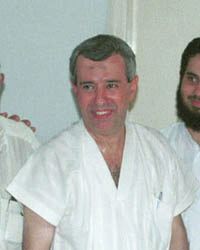 |
| Vol. 2 No. 8 | Table of Contents MEIB Main Page | 5 September 2000 |
 |
| Hashem Minqara |
On August 21, Sheikh Hashem Minqara suddenly reappeared in his hometown of Tripoli in northern Lebanon after spending nearly fourteen years in a Syrian prison. His relatives, who were not expecting him, were surprised and understandably overjoyed--last October, a Lebanese detainee held by the Syrians was returned to his family in a body bag.1
Minqara was a leading figure in the Tripoli-based Harakat al-Tawhid al-Islami (Islamic Unity Movement), a Sunni Muslim fundamentalist group allied with Yasser Arafat's PLO during the mid-1980's. In September 1985, the Tawhid al-Islami was involved in a bloody war for control of the city against the Arab Democratic Party (ADP), the Syrian Social Nationalist Party (SSNP) and other pro-Syrian militias. This led Syrian military forces to directly occupy the city in November.
The leader of Tawhid al-Islami, Sheikh Said Sha'aban, bowed to Syrian authority and grew increasingly close to Damascus over the next year. But Minqara, who was in charge of the al-Mina port area of the city, and other key commanders rejected this decision. On December 19, 1986, armed guerrillas loyal to Minqara launched attacks on Syrian checkpoints in the city, killing 15 soldiers. Syrian forces swiftly closed the Tripoli-Beirut road to the south and the Tripoli-Akkar road to the north, then sealed off the predominantly Sunni district of al-Tabbaneh in the western part of the city, where the group's headquarters were located.
At dawn the next day, Syrian commandos and special forces units launched a three-pronged attack on the district, entering from the north, south and east. The soldiers combed through the entire district, meeting heavy resistance from Tawhid al-Islami guerrillas. Scores of Minqara's followers were arrested in house to house searches and over 200 people were killed in the 36-hour operation--according to Amnesty International, many of the killings were deliberate murders that could not be attributed to the fighting.2
Minqara and a small band of Tawhid al-Islami fighters miraculously managed to escape from the city during the onslaught and Syrian forces launched a massive manhunt in outlying districts. On December 26, they were finally tracked down by the Syrians in the Dinniyyah region east of Tripoli. After a brief clash which left seven of his followers dead, Minqara was captured. He was initially taken to Tripoli for interrogation by Syrian military intelligence, then transferred three days later to Syria.
For the next fourteen years, Minqara was held in Saidnaya prison, north of Damascus. Little is known about the precise conditions of his imprisonment, but other Tawhid al-Islami members who were captured and subsequently released reported being brutally tortured during their detention.
After his return to Lebanon, Minqara told a local newspaper that his release was negotiated by Lebanese Minister of Transportation Najib Miqati, a Sunni politician from Tripoli who has close business ties with Syrian President Bashar Assad and is said to be under consideration in Damascus as the next prime minister of Lebanon.3 Lebanese political analysts have speculated that Minqara's release was designed to bolster local support for Miqati and his allies in the August 27 parliamentary elections.
Like most other detainees released by the Syrians in recent years, Minqara was first taken to the headquarters of Syrian intelligence in Anjar, Lebanon, where he presumably signed a pledge not to engage in political activity.4 He then walked outside, stepped inside a car provided by the Lebanese Public Works Ministry and returned home.
Bilal Shaaban, the current secretary-general of Al-Tawhid al-Islami, suggested that a deal had been reached to secure the release of other members of the group held by Syria. "The release of all our imprisoned brothers should come in the next few days."5 Another one of the group's military commanders, Samir al-Hassan, was released earlier this month.
The number of Lebanese citizens illegally held in Syrian prisons is not known for certain because Damascus adamantly refuses to release any information on their whereabouts and relatives of the prisoners are often afraid to publicly raise the issue. Former President Elias Hrawi recently said that the number of detainees is 165, but the Lebanese human rights group MIRSAD estimates that it is a "four digit" number.
1 Death of Lebanese Detainee in Syria Sparks International Outcry, Middle East Intelligence Bulletin, November 1999.
2 Lebanon: Arbitrary Arrests, "Disappearances" and Extrajudicial Killings by Syrian Troops and Syrian-backed Forces in Tripoli (AI Index: MDE 24/02/87), February 1987.
3 Al-Safir (Beirut), 22 August 2000.
4 Al-Nahar (Beirut), 22 August 2000.
5 Al-Nahar (Beirut), 22 August 2000.